Thursday 14th July 2022

There have now been 11 deadlines for Government funding support for TfL since the pandemic began in late March 2020.
That’s an average of one deadline every 78 days. Or one very two and a half months.
Bearing in mind the first funding settlement lasted for six and a half months and the second and third for six and seven months respectively you can tell much of the short-termism is coming from small extensions lasting a matter of a fortnight or so to try and reach the coveted longer term funding settlement everyone knows is essential but remains elusive.
If like me, you’re thinking ‘we’ve been here before’ here’s the list of deadlines and extensions since it all began in April 2020.
- 17th October 2020
- 31st October 2020
- 31st March 2021
- 18th May 2021
- 28th May 2021
- 17th December 2021
- 4th February 2022
- 18th February 2022
- 24th June 2022
- 13th July 2022
- 28th July 2022
To no surprise to anyone and as is all so typical, news only came through yesterday afternoon that last night’s midnight deadline was indeed being extended by yet another 15 days. Quite what is going to happen in the coming 15 days that didn’t happen in the 19 days between the previous deadline (24th June) passing and its extension to yesterday is beyond me.
DfT states “TfL have been unable to provide information sufficiently demonstrating that conditions outlined in the current funding settlement are on track and reassure the Government that any long-term settlement will be in the interest of all UK taxpayers”.
Is that situation really going to change by two weeks today? I doubt it. It looks like this ongoing political battle is set to continue with yet more deadlines and extensions.
Meanwhile TfL has also got in on this deadline extension trend by extending its own cut off date for consultation responses into the central London bus cuts, which was Tuesday this week, and is now extended to 7th August.
At the same time TfL is continuing its rolling programme of week by week frequency reductions across many other routes.
The latest reductions will impact passengers in the Barnes and Mortlake area from this Saturday when frequencies will be halved on two bus routes that were impacted when Hammersmith Bridge closed at short notice three years ago.

Frankly it’s a scandal it’s taken three years to make this change.

An initial hiatus pertained between the Bridge closing in May 2019 and August 2019 when a revised pattern of routes was established and has run ever since, yet it’s been plain to see just how over-bussed and under-passenger-supported these contingency arrangements have been, never mind the lockdown periods when the buses must have been mobile fresh air transporters devoid of passengers.
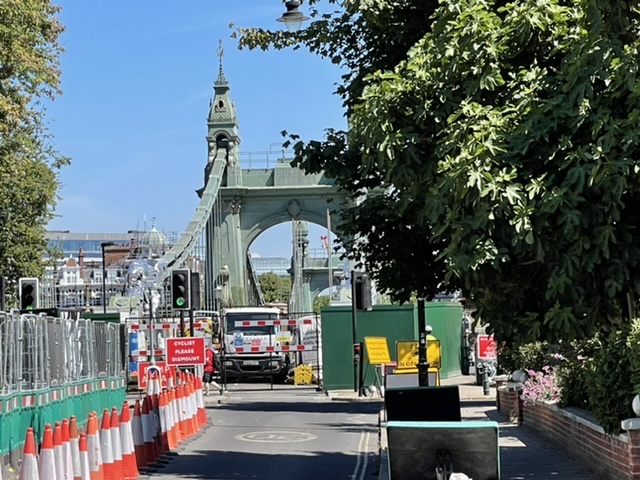
On previous visits to the Barnes area since the Bridge closure I’ve been taken aback at just how many buses have been chasing so few passengers so with the impending cuts from this Saturday I paid another visit on Monday just to check the situation hasn’t changed.
It hasn’t.
It takes ten minutes to walk from Hammersmith Underground station across the Bridge…

… to the south side in Castelnau where buses can be found.

However if that’s too much (maybe due to a disability), temporary route 533 takes the long way round from Hammersmith bus station via Chiswick Bridge before operating a clockwise circuit between Barnes and the south side of the Bridge at Castelnau and back again. This runs every 15 minutes and will continue to do so during the daytime with only a minor frequency reduction in the peaks (to a non memorable every 17 minutes), presumably to counteract traffic delays, from Saturday.
It takes 26 minutes to reach the south side of Hammersmith Bridge. Five buses are needed to run the service and this won’t change from Saturday.

Loadings on the 533 seem to be reasonable for what it is. It currently runs non stop between Mortlake Cemetery and Hammersmith Bridge but will now observe five additional stops on that section.

The two routes which are seeing their frequencies halved are the 209 (from every 15 to every 30 minutes) and 378 (from every 7-8 to every 15 minutes).
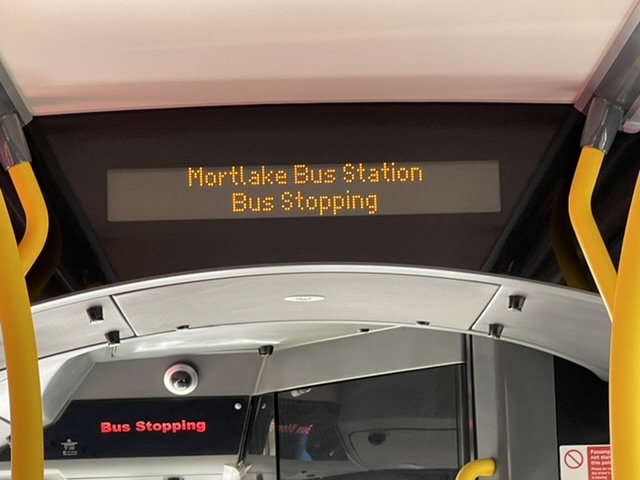
Both routes start in the grandly named Mortlake bus station – a small turning area situated at the end of Avondale Road, a no through road.

Route 209 operates via Barnes to the south side of Hammersmith Bridge at Castelnau – the end to end journey time is just 10 minutes.

It used to continue over the Bridge to Hammersmith, being the rump end of long standing trunk route 9 which was cut back to Hammersmith in 1992.
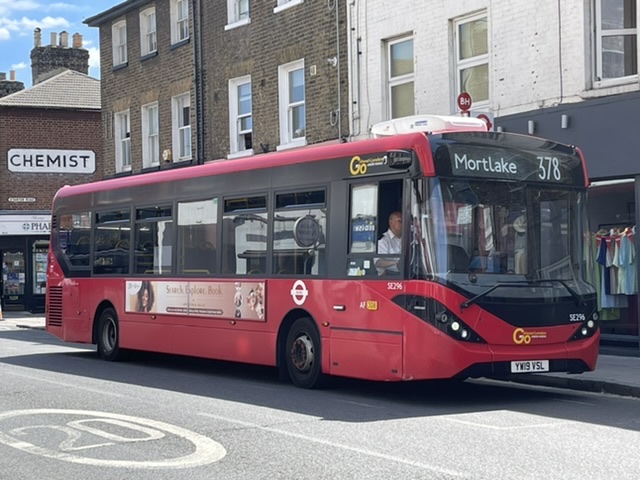
Route 378 is another Bridge closure related route, introduced in August 2019, and runs to Putney Bridge station (on the north side of the River Thames) enabling passengers to reach an Underground station now that Hammersmith is more awkward to reach (either that 10 minute walk over the Bridge or the 533).

It’s also been routed along Mill Hill Road – to the west and south of Barnes Pond and thanks to the positioning of (or lack of) bus stops in the popular shopping area near Barnes Pond it’s been useless to reach there as passengers travelling from Mortlake haven’t been able to alight in Barnes itself.

Three years on this is being corrected by diverting the route via Church Road as per route 209.

It takes 14-15 minutes to travel from Mortlake to Putney Bridge.
Routes 209 and 378 interwork at Mortlake (revolutionary for London, eh?) and amazingly for these two short stubs of routes, the peak vehicle requirement is ten. That must work out at an operating cost of at least £1.5 million per annum – and over the last three years, £4.5 million – so I dread to think what the cost per passenger has been, and I’m not counting the cost of route 533 as that could be said to have replaced the 209 cost as was before the closure.
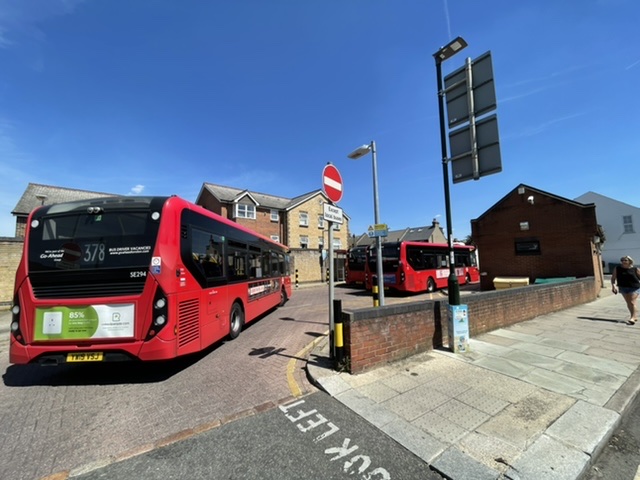
On my journeys up and down routes 209 and 378 on Monday there were pitifully few passengers travelling on any of the buses I saw or rode on. Two journeys had just myself on board.

One bus on route 209 I caught from the south side of Hammersmith Bridge (at Castelnau) to Mortlake followed a bus on route 533 for all of the ten minutes it took to reach the Avondale Road junction so not surprisingly no-one travelled.

I notice the timetables show these 15 minute frequency routes should be five/ten minutes apart so the 533 must have been running a bit late.
I’m not sure route 209 is doing anything useful any more and could really be withdrawn completely. In the Mortlake direction it’s covered by route 533 and the re-routed 378 combined with route 485 provide a replacement in the Castelnau direction.
That would cut out another bus from Saturday – making six buses saved.
From August 2020 Hammersmith Bridge was closed completely even to pedestrians and cyclists. That put paid to the idea of an enterprising entrepreneur setting up a ‘Pedi-Cab’ bike taxi service I had fun trying out during summer 2019.

After that full closure there was much talk during lockdown between the DfT and TfL about setting up a ferry service across the River and Thames Clipper were gearing up for it only for the Bridge to reopen to pedestrians and cyclists (who now have to dismount as they walk across) a year ago in July 2021.

It’s not that I’m critical of TfL for that situation, the Bridge closure has decimated travel patterns in this part of London, it’s just the length of time it takes for any adjustments to be made to service provision once it’s clear for all to see there’s a mismatch and vast sums are simply being wasted.
It’s this same lethargy resulting in deadline extension upon extension which is bedevilling the finalising of Government funding during discussions with the DfT, whose reputation for procrastination (think rail fares reform) is as bad as TfL’s.
No wonder it just keeps rolling on with no end in sight. It’s almost a dead cert this latest 28th July deadline will be extended.
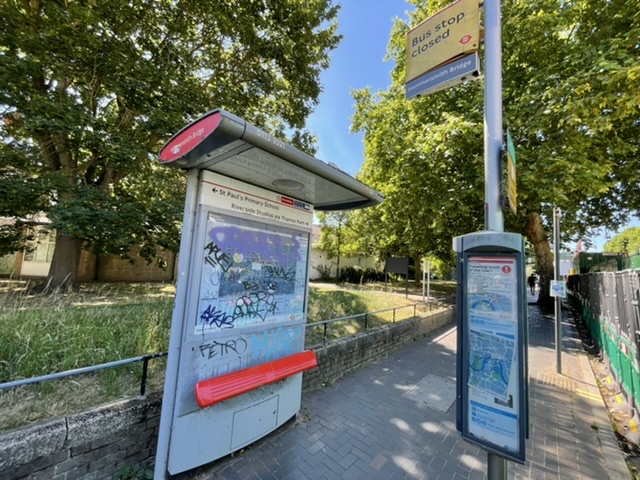
Roger French
Blogging timetable: 06:00 TThSSu


If Boris had sorted out Hammersmith Bridge instead of wasting time and money on his garden bridge, it might (just) have created some point to his time as mayor…
LikeLiked by 1 person
TfL seem unwilling to cut services to match current demand. They have so far not dealt with the excess rail capacity at all nor looked art cutting management and admin costs
TfL have had in excess of £5B in support to cover a period of little more then a year. They cannot carry on as they are at present. In comparison the rest of England has had just £1.4B
LikeLike
Hammersmith Bridger is not the responsibility of Westminster
LikeLike
Roger, as much as I enjoy your blogs, I find the implication that some people can’t be bothered to make the ten minute walk across Hammersmith Bridge rather offensive. If you suffered from any walking disability or needed, as many do, to carry two heavy bags of shopping – or simply wanted to avoid getting soaked during a downpour, I doubt you would be quite so critical. And for myself and many others I know the 533 is a lifesaver.
On a separate category regarding the Hammersmith Bridge area, some map displays (eg. at Barnes Bridge station) still show buses crossing the bridge!
LikeLike
Reassuring you Peter that my phrase “if that’s too much for you” was absolutely meant in the event of those with disabilities finding it “too much” and certainly not “can’t be bothered” as you surmised which never entered my thoughts.
LikeLiked by 1 person
Thank you Roger, explanation accepted. The politics of the bridge fiasco have sharpened the sensitivities of all those affected by its closure.
LikeLiked by 1 person
Have just updated the wording so there’s no chance of ambiguity. Thanks for raising this Peter.
LikeLike
This might be of interest: https://www.route-one.net/news/recovery-funding-for-bus-services-in-wales-extended-into-2023/
LikeLiked by 1 person
Hi Roger,
You continue to feature some of my old haunts – I was operating in the Barnes – Hammersmith area when the bridge’s instability first became a major problem. The Borough Council’s Engineer and Bridgemaster (I think he really did have that title) explained to me how the bridge’s structure meant that a single point of failure could cause the bridge to, in his words, “unzip”, which he illustrated by unfolding his hands downwards. Engineers can be quite good at explaining things to non-engineers!
Anyway, allow me to make a correction to what you wrote. The 9 was cut back to Hammersmith in 1992, not 1997, principally due to a weight limit imposed on the bridge, but it dovetailed perfectly with my plan to convert to high frequency midibus operation wherever I could in readiness for deregulation in London. The Hammersmith-Mortlake section became the 9A (now the 209). The Avondale “bus station” was the front of the site of Mortlake Garage – I assume you knew that?
As with all frequency improvements, we saw passenger growth and had to keep increasing the frequency to deal with loadings. For a brief period, the 9A was the highest frequency bus service in London, even outdoing the 38, with 29 bph at the peak of the peak. All other routes over the bridge were (or already had been) converted, so I found myself happily being the sole operator on a plum corridor with 50 bph in total! Then the Government got cold feet and called off deregulation in London!
So now the question: where did all those passengers go, given the poor ridership levels you observed?
I keep enjoying every one of your blogs!
Best wishes
David
Sent from my iPad
>
LikeLiked by 1 person
Thanks very much for all that fantastic and fascinating background. I’d forgotten about the high frequency era in the 9A. Amazing to think of such a high frequency. I’ll update the year to 1992 and many thanks again.
LikeLiked by 1 person
TfL have just announced they need another £275M before the next phase
Transport for London’s Group Finance Director, Patrick Doig, revealed the next phase might need another £275million to be completed or Crossrail chiefs “won’t have the funds needed to complete the rest of the scheme.” He told the London Assembly: “[TfL boss] Andy Byford promised that additional funding would not exceed £1.1bn.
TfL’s budget and project control both seem to be totally out of Control. Quite what is this money for? They are supposed to be in the final testing stages so should be no need for additional funding
Even more concerning is it could be £1.1B needed
LikeLike
So TfL is operating under a funding system of the government’s creation, primarily from fares, they took away the central government grant (after Boris ceased to be mayor I think). This is unlike any other developed world city. Then Covid decimated customer numbers and therefore revenue. Now the government is punishing TfL for a situation of its own making.
I’m not aware of any funding crisis elsewhere in Europe, in fact I’ve just read in the latest edition of Tramways & Urban Transit that Montpelier has placed a large order with CAF for new trams for a new line, and general fleet expansion in.preparation for abolition of fares altogether.
LikeLike
And just think, in a few years we will have TfL style demands for £support all over England thanks to George Osborne creating ridiculous and unnecessary “Mayors” who think the London system needs to be copied.
A snapshot of TfL’s total inflexibility, and why they are in such a mess, came under my nose a few months ago. I suggested a very logical service change, actually involving three routes (two to be extended, and one withdrawn) which would have probably saved way over a £million a year and would have gone unnoticed by the public other than a new link created. The response was, “thank you very much, but we cannot change anything as we have just re-let the contract”. For seven years! So the 209/378 changes are at lightning speed by comparison.
LikeLike
TfL has lost the ability to think outside the box. There are countless daytime routes that don’t have the demand to warrant running until 01.30. This would give massive scope for savings before taking a chainsaw to the central London network. The West End only has three Tube stations that are step-free, so buses are absolutely vital for people such as myself who have difficulty walking any distance or cycling either for that matter.
LikeLike